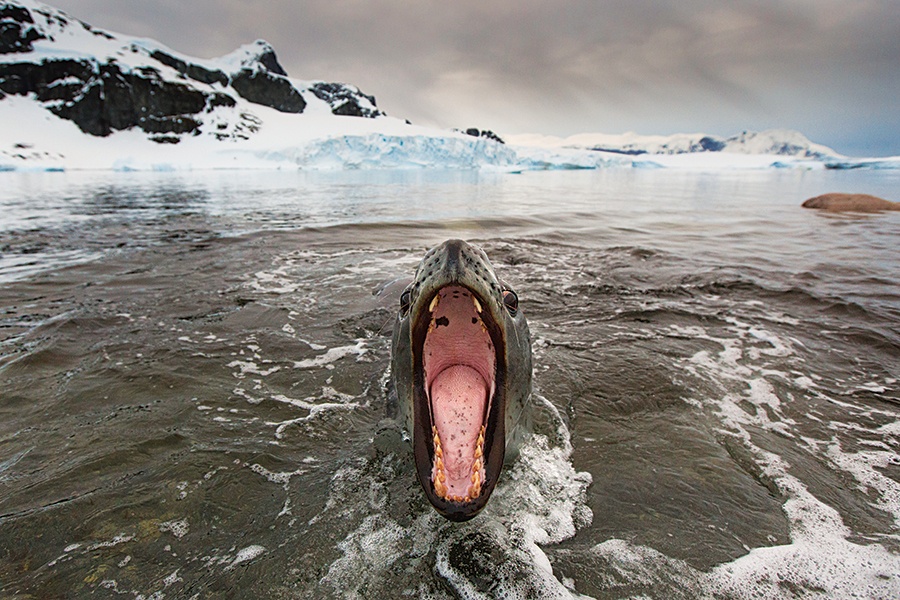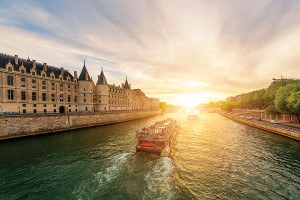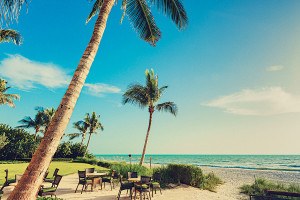Into the Antarctic Void: My Luxury Cruise to Breathtaking Desolation
At the bottom of the world, our intrepid explorer found beauty, terror, and a bundle of contradictions.

The wondrous Gerlache Strait near Cuverville Island, just one stop on the author’s Antarctica cruise. / Photo by Mike Hill/Getty Images
I have a photo of myself standing high on a ridge overlooking Neko Harbor in Antarctica. I appear to be smiling, and my hatless head makes it look balmy out. But, you know, Instagram vs. Reality.
The truth is that it was freezing and windy. The climb up to where the photo was taken was a steep, ankle-twisting path that members of the expedition team had carefully marked so that no one would fall into a crevasse. Plus, I really had to use the bathroom, which meant getting back to the ship. The exertion made me sweat, which is why I took my hat off. As for the look on my face, it might be relief, because I have a cardiomyopathy and I hadn’t suffered a heart attack in a place with no hope of meaningful medical attention. Just before the photo was taken, I’d peered down into a frozen abyss, a slurry of gunmetal-gray water and floating ice that made the soles of my feet tingle.
How I wound up there was rather serendipitous. At a book party in Boston, I was talking to a woman who owns a PR firm that specializes in luxury travel.
“Have you ever done a story about a cruise?” she asked.
“No. I hate being a captive audience,” I said. “I’d feel like penned veal on one of those giant ships.”
“This is an expedition cruise,” she countered, piquing my curiosity. “It’s the maiden voyage of a new Silversea ship to Antarctica. The only thing is that you might miss Thanksgiving. The expedition ends the Tuesday before.”
At that point, I knew roughly three things about Antarctica: The South Pole is there; despite decades of travel writing, it was the only continent I’d never set foot on; and there are lots of penguins. I was sold.
“I’ll take penguins over turkey any day,” I told her.
There was something else in my desire to visit the bottom of the earth on a ship full of strangers: a major, existential-grade case of FOMO. It’s impossible to ignore that Antarctica is melting. Some of its major ice shelves are cleaving into the ocean, threatening to raise sea levels around the world. I wanted to see the last great frontier before it was too late. What I didn’t realize was that my time visiting the planet’s most vulnerable and inhospitable place would also make me feel more vulnerable than I’d ever felt before.

Penguins on Cuverville Island could be found at every turn. / Photo by Oversnap/Getty Images
My first inkling of how exposed Antarctica would make me feel came when I considered my luggage mid-flight en route to Chile. Silversea would issue me a bright-red parka, thick-soled boots, and snow pants, but I had to scour my winter clothing and ski gear for everything else: long underwear, wicking layers, gloves, hats, balaclavas, turtlenecks, hand and toe warmers, and anything else to keep me warm. As I hurtled toward South America, I realized I’d never worried about an airline losing my luggage before. Upon arrival, you can always pop into a store and buy whatever you need. But at 35,000 feet, it occurred to me that if my suitcase went missing this time, I’d be completely screwed.
Luckily, my bag was there when I arrived, and fortunately, I didn’t have to spend too much time in Santiago, my least favorite city in South America. Its Anglo-Germanic vibe feels like a slap in the face after traveling so far in an entirely different direction from Europe. I joined the other passengers for an overnight at a five-star hotel. Because this was an inaugural voyage, the group consisted of other journalists, Silversea executives, and travel professionals who sell $26,000 adventures to rich people with bucket lists (a concept I abhor, because playing Beat the Clock against the inevitable strikes me as an unnecessarily depressing way of going through life).
At the welcome dinner, I was introduced to Felicity Aston, the Silver Endeavor’s “godmother,” who would be given the honor of christening the ship once we reached Antarctica. Aston was the first woman to cross the continent alone and the first human being ever to do it without any mechanical assistance. “You must be completely insane,” I said by way of greeting. Thankfully, she laughed before conceding that hers had been an unusual undertaking. “What possessed you to do it?” I asked.
“I look forward to showing you,” she said.
The next morning, we took a chartered jet to Puerto Williams, Chile, the southernmost town on the planet, and boarded the ship. To say it was dazzling is an understatement. Its interior was replete with velvet upholstery and gleaming brass and marble. There was a spa with a sauna and steam room, an outdoor whirlpool, an indoor swimming pool, four restaurants, a well-appointed library, a cigar lounge, and an observation deck with a bar. My suite had a king-size bed, walk-in closet, sofa, desk, balcony, and a minibar furnished with cut crystal. I also had an attentive butler named Rodolfo, who spent his days dreaming up ways to spoil me.
The irony of being ensconced in such luxury while heading into such hostile territory was not lost on me—it was a dissonant seesaw between the sybaritic and the hazardous. Even as I basked in my surroundings that first night, a case of the heebie-jeebies overcame me at the prospect of navigating the Drake Passage. It’s the world’s roughest crossing, the spot where the Atlantic and Pacific oceans converge. Waves of up to 90 feet have been recorded.
I’m no shrinking violet when it comes to outdoor adventure: I’m trained as a white-water rafting guide, been diving all around the world, skied on four continents, wrangled camels with the Bedouin in Wadi Rum, and radio-collared wolves in the grasslands of Brazil. But I’ve never felt so threatened by a place as I did in Antarctica. A mandatory safety briefing only added to my anxiety. The explanations of emergency procedures and lifejacket protocol simply highlighted everything that could go wrong.
From the shelter of the Beagle Channel in Tierra del Fuego, it seemed like we might get the so-called “Drake Lake” as opposed to the “Drake Shake.” But at 2 a.m., I found myself nearly falling out of bed. When I got up, I had to brace myself to get to the bathroom. The ship’s state-of-the-art stabilizers couldn’t completely erase the effects of 36-foot swells. I poked my head out the sliding door of my balcony. The wind was keening, and waves crashed against the ship, sending up great ropy gouts of spray. I took a Xanax—or three—and went back to bed, trying to imagine being in a cradle as opposed to a washing machine. Blessedly, the antiemetics I’d also taken did their job because, judging by the other passengers’ ashen complexions and dry toast for breakfast the next morning, I estimated that half the ship had spent the night reacquainting themselves with dinner.
If the Drake Passage wasn’t enough to shake me, later the next day, the former president of the Royal Geographical Society, Nicholas Crane, gave a lecture on Ernest Shackleton—one of the most important Antarctic explorers—and his ill-fated voyage to Antarctica. His ship, the Endurance, was discovered just last year in nearly 10,000 feet of water after being crushed by pack ice and sinking in 1915.
When we finally made landfall at Robert Island, the northern edge of the end of the earth, and at subsequent landings in places such as Cuverville and Petermann islands, there were other dangers to contend with. While exploring, I had to watch where I put my feet at every moment. To veer off the track established by the expedition team could mean plummeting into a hidden, icy chasm. Weather was also a factor. The temperature could be a balmy 35 degrees and drop within minutes into the low 20s. The blue skies could change to a whiteout in an instant. And the incessant, unpredictable winds could quickly turn a pleasant ride in the zodiac into a white-knuckle ordeal. Most alarming of all: I learned one evening at dinner that two passengers on another ship had been killed when their zodiac capsized.
Still, the fear I felt was always adjacent to a sense of absolute wonder. I struggled to follow the rule of staying 15 feet away from the wildlife, because animals were everywhere. Disembarking from a zodiac, I stepped dangerously close to a submerged leopard seal, a highly aggressive predator. I was often unable to advance because of a penguin waddling straight for me. There were elephant seals, fur seals, and whales. I saw three kinds of penguins—Adélie, chinstrap, and gentoo—in colonies so massive they were louder than a bare-knuckle boxing match and smellier than low tide.
What surprised me, though, was that the landscape, not the wildlife, stole the show. In the ice, I saw electric shades of blue I had never known existed in nature. The desolation was breathtaking; it was uncanny how a place so bleak could be so beautiful—yet still so haunting.

Leopard seals. / Photo by Paul Souders/Getty Images
There are almost no signs of human life in Antarctica. It’s the only place I’ve ever been where I didn’t see a single piece of trash. There is no culture there. No Indigenous people. No souvenirs or trinkets to bring home. It’s utter emptiness. A void.
We went to great lengths to introduce nothing foreign to the place. Any gear we brought ashore was inspected beforehand for foreign sand, soil, or seeds. We sterilized our boots before leaving the ship. We were forbidden from kneeling, sitting, or even resting anything on the ground. If nature called, we just had to hold it.
There were only the faintest, most ephemeral signs of mankind, which made me feel more alone than I ever had. Antarctica has a raw indifference to human life that makes it impossible to ignore for even a second—a sharp reminder that one could die at any moment. I had emergency heart surgery at age 39, so I’m well acquainted with the tentative nature of life, but Antarctica amplified that feeling for me. Whatever you bring there is thrown into stark relief against the blank canvas of its frozen, white terrain, and all you can really bring there is yourself.
Antarctica drew out a darkness in me, a terrible sense of what Holocaust survivor and psychiatrist Viktor Frankl described as an “existential vacuum,” or a sense of meaninglessness. Staring at such monumental implacability made me feel pointless. It showed me just how small I am, smaller than the krill that feed the food chain or the handful of species of lichens that survive there. Despite my heart condition, it’s a powerlessness I’m unaccustomed to.
One evening, I found myself sitting on my balcony, watching a humpback whale cavorting off the starboard side. I saw the black-as-anthracite water and icebergs floating ominously by, and a tiny voice in my head kept saying, if you hopped over the railing, nothing could save you. I’m not prone to life-threatening impulses, but that reality was like a “wet paint” sign tempting me to test it. It was as if this otherworldly environment was taunting me with my own mortality. No other place has ever given me so much to talk about with my psychiatrist.
Since returning home, I’ve had numerous conversations during which somebody asks, “Was Antarctica fun?” I respond, “That’s not exactly the word I’d use.” I explain that it’s a bundle of contradictions—astonishingly beautiful yet absolutely terrifying, forbidding yet captivating, exhilarating yet enervating. I say that you feel as though your life is at risk every second, which only emphasizes the fact that your life is at risk even asleep in your own bed.
Invariably, someone asks, “Would you ever go back?” Without hesitation, I reply, “In a heartbeat.” But now I realize that my impulse to see—or, worse, to return—to the last unpopulated continent before climate change either alters or erases it altogether was tinged with Titanic hubris. My carbon footprint alone from going somewhere I technically had no need to be—other than bragging rights and putting another pin in the map of the world that I use to trace my travels—was ethically questionable.
I hope everything I learned in Antarctica stays with me and informs my future decisions. I hope I’m more thoughtful with regard to my life in general and make more sensitive choices with regard to my impact on climate change and the environment. Antarctica is a place to be approached with reverence and respect, not just champagne and caviar. And I know that just as I returned to the comforts of a luxury ship after every landing, it’s easy to forget those lessons when you’re surrounded by the familiar. That’s why I love that picture of me in Neko Harbor, where I’m hatless and looking happy. I want to remember the feeling of awestruck emptiness I experienced there, even if the photo appears to tell a different story.
First published in the print edition of the May 2023 issue with the headline “Into the Void.”


